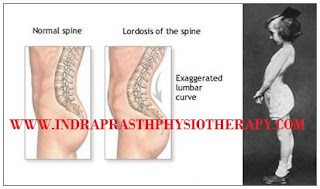LORDOSIS - The term lordosis refers to the normal inward lordotic curvature of the lumbar and cervical regions of the spine. Excessive curvature of the lower back is known as lumbar hyperlordosis, commonly called hollow back. A major feature of lumbar hyperlordosis is a forward pelvic tilt, resulting in the pelvis resting on top of the thighs. Curvature in the opposite convex direction, in the thoracic and sacral regions is termed kyphotic. Lordosis is an increased inward curving of the lumbar spine. The spine has three types of curves:
lordotic, kyphotic and scoliotic.
A small degree of both kyphotic and lordotic curvature is normal. Too much lordotic curving is called swayback (lordosis). Too much kyphotic curving causes round shoulders or hunched shoulders
Lordosis tends to make the buttocks appear more prominent. Children with hyperlordosis will have a large space underneath the lower back when lying face up on a hard surface. Some children have marked lordosis, but, most often fixes itself as the child grows. This is called benign juvenile lordosis. Spondylolisthesis may cause lordosis. In this condition, a bone in the spine slips out of the proper position onto the bone below it. You may be born with this. It can develop after certain sports activities, such as gymnastics. It may develop along with arthritis in the spine.
A small degree of both kyphotic and lordotic curvature is normal. Too much lordotic curving is called swayback (lordosis). Too much kyphotic curving causes round shoulders or hunched shoulders
Lordosis tends to make the buttocks appear more prominent. Children with hyperlordosis will have a large space underneath the lower back when lying face up on a hard surface. Some children have marked lordosis, but, most often fixes itself as the child grows. This is called benign juvenile lordosis. Spondylolisthesis may cause lordosis. In this condition, a bone in the spine slips out of the proper position onto the bone below it. You may be born with this. It can develop after certain sports activities, such as gymnastics. It may develop along with arthritis in the spine.
Lordosis symptoms
Symptoms of this abnormality depend upon the severity of the disease. Lordosis symptoms may include:- C-shape back when seen from a lateral aspect, with the buttocks being more prominent
- A large gap between the lower back and the floor when lying on one’s back
- Pain and discomfort in the lower back.
- Problems in moving in certain ways.


No comments:
Post a Comment